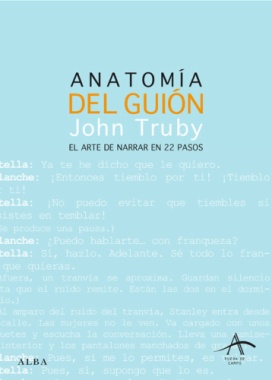Basado en las clases magistrales de John Truby, Anatomía del guión aborda conceptos y arquetipos extraídos de la filosofía y la mitología para transformarlos en una técnica actualizada para la redacción de guiones cinematográficos de gran profundidad narrativa.
El método de Truby es tan brillante como práctico. Su desarrollo se fundamenta en el crecimiento emocional y moral de sus protagonistas, y ofrece a lectores —profesionales y aficionados— multitud de herramientas y técnicas específicas para lograr que los personajes cobren sentido y el público conecte con ellos; ofrece además recursos para construir tramas sorprendentes, siempre con el sello personal del propio autor. Los 22 pasos para la composición de un guión que propone Truby se pueden aplicar a todo tipo de escritos, desde novelas y cuentos, a artículos periodísticos, memorias y ensayos. Son, sin embargo, en el guión donde han probado su mayor eficacia.
- Cubierta
- Dedicatoria
- Agradecimientos
- 1. El espacio de la historia, el tiempo de la historia
- EL NARRADOR Y EL OYENTE
- LA HISTORIA
- EL CUERPO NARRATIVO
- MOVIMIENTO DE LA HISTORIA
- ESCRIBIR NUESTRA HISTORIA
- 2. La premisa
- QUÉ ES LA PREMISA
- CÓMO DESARROLLAR NUESTRA PREMISA
- 3. Los siete pasos clave de la estructura narrativa
- 1. DEBILIDAD Y NECESIDAD
- LA TÉCNICA DE LOS SIETE PASOS: CREAR LA NECESIDAD MORAL
- 2. DESEO
- LA TÉCNICA DE LOS SIETE PASOS: EMPEZAR POR EL DESEO
- 3. ADVERSARIO
- 4. PLAN
- 5. LUCHA
- 6. AUTORREVELACIÓN
- 7. NUEVO EQUILIBRIO
- 4. El personaje
- RED DE PERSONAJES
- RED DE PERSONAJES SEGÚN LA FUNCIÓN NARRATIVA
- LA RED DE PERSONAJES SEGÚN EL ARQUETIPO
- INDIVIDUALIZAR PERSONAJES EN LA RED
- CREACIÓN DE NUESTRO PROTAGONISTA
- CONSTRUIR EL CONFLICTO
- 5. El argumento moral
- ENCONTRAR EL HILO TEMÁTICO EN EL PRINCIPIO FUNDADOR
- SEPARAR EL TEMA EN OPOSICIONES
- EL TEMA A TRAVÉS DE LA ESTRUCTURA
- VARIANTES DEL ARGUMENTO MORAL
- COMBINAR ARGUMENTOS MORALES
- LA VISIÓN MORAL ÚNICA
- EL ARGUMENTO MORAL EN EL DIÁLOGO
- 6. El mundo de la historia o mundo narrativo
- ENCONTRAR EL MUNDO NARRATIVO EN EL PRINCIPIO FUNDADOR
- LA ARENA DE LA HISTORIA
- DETALLAR EL MUNDO NARRATIVO
- CONECTAR EL MUNDO CON LA EVOLUCIÓN GENERAL DEL PROTAGONISTA
- EL TIEMPO EN EL MUNDO NARRATIVO
- EL MUNDO NARRATIVO A TRAVÉS DE LA ESTRUCTURA
- 7. La red de símbolos
- CÓMO FUNCIONAN LOS SÍMBOLOS
- RED DE SÍMBOLOS
- SÍMBOLOS NARRATIVOS
- PERSONAJES SIMBÓLICOS
- TEMAS SIMBÓLICOS
- EL SÍMBOLO PARA EL MUNDO NARRATIVO
- ACCIONES SIMBÓLICAS
- OBJETOS SIMBÓLICOS
- RED DEL MITO SIMBÓLICO
- TÉCNICA DE LOS SÍMBOLOS: INVERTIR LA RED DE SÍMBOLOS
- 8. La trama
- TRAMA ORGÁNICA
- TIPOS DE TRAMA
- CREAR UNA TRAMA ORGÁNICA
- LA ESTRUCTURA NARRATIVA DE LOS VEINTIDÓS PASOS
- SECUENCIA DE REVELACIONES
- EL NARRADOR
- 9. El tejido o entramado de escenas
- ENTRAMADO DE ESCENAS DE TRAMAS MULTIARGUMENTALES
- ENTRAMADO DE ESCENAS EN LAS HISTORIAS DE DETECTIVES O POLICÍACAS
- ENTRECRUZAR EL ENTRAMADO DE ESCENAS
- ENTRAMADO DE ESCENAS EN HISTORIAS ROMÁNTICAS
- ENTRAMADO DE ESCENAS EN LAS FANTASÍAS SOCIALES
- 10. La construcción de escenas y el diálogo sinfónico
- CONSTRUCCIÓN DE LA ESCENA
- ESCENAS COMPLEJAS O CON SUBTEXTO
- DIÁLOGO
- ESCENAS
- OBRAS MAESTRAS EN CONSTRUCCIÓN DE ESCENAS
- 11. La historia que nunca acaba
- Créditos
- Alba Editorial

